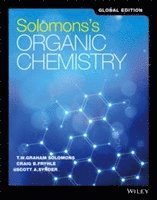
- Format
- Häftad (Paperback / softback)
- Språk
- Engelska
- Antal sidor
- 1216
- Utgivningsdatum
- 2017-06-27
- Upplaga
- 12 ed
- Förlag
- John Wiley & Sons Inc
- Dimensioner
- 277 x 217 x 36 mm
- Vikt
- ISBN
- 9781119248972
- 2344 g
Solomons' Organic Chemistry, Global Edition
Kundrecensioner
Fler böcker av författarna
-
Organic Chemistry, International Adaptation
T W Graham Solomons, Craig B Fryhle, Scott A Snyder
-
Molecular Modeling Kit to accompany Organic Chemistry, 7e
T W Graham Solomons, Craig B Fryhle, T W Graham Solomons, Craig B Fryhle
-
Japan-South Korea Identity Clash
Brad Glosserman, Scott A Snyder
-
South Korea at the Crossroads
Scott A Snyder
Övrig information
T.W. Graham Solomons did his undergraduate work at The Citadel and received his doctorate in organic chemistry in 1959 from Duke University where he worked with C.K. Bradsher. Following this he was a Sloan Foundation Postdoctoral Fellow at the University of Rachester where he worked with V. Boekelheide. in 1960 he became a charter member of the faculty of the University of South Florida and became Professor of Chemistry in 1973. In 1992 he was made Professor Emeritus. His research interests have been in areas of heterocyclic chemistry and unusual aromatic compounds. He has published papers in the Journal of the American Chemical Society, the Journal of Organic Chemistry, and the Journal of Heterocyclic Chemistry. He has received several awards for distinguished teaching. Craig B. Fryhle is Chair and Professor of Chemistry at Pacific Lutheran University. He earned his B.A. degree from Gettysburg College and Ph.D. from Brown University. His experiences at these institutions shaped his dedication to mentoring undergraduate students in chemistry and the liberal arts, which is a passion that burns strongly for him. His research interests have been in areas relating to the shikimic acid pathway, including molecular modeling and NMR spectrometry of substrates and analogues, as well as structure and reactivity studies of shikimate pathways enzymes using isotopic labeling and mass spectrometry.
Innehållsförteckning
1 The Basics BONDING ANDMOLECULARSTRUCTURE 1 1.1 Life and the Chemistry of Carbon CompoundsWe Are Stardust 2 1.2 Atomic Structure 3 1.3 Chemical Bonds: The Octet Rule 5 1.4 HOW TO Write Lewis Structures 7 1.5 Formal Charges and HOW TO Calculate Them 12 1.6 Isomers: Different Compounds that Have the Same Molecular Formula 14 1.7 HOW TO Write and Interpret Structural Formulas 15 1.8 Resonance Theory 22 1.9 Quantum Mechanics and Atomic Structure 27 1.10 Atomic Orbitals and Electron Configuration 28 1.11 Molecular Orbitals 30 1.12 The Structure of Methane and Ethane: sp3 Hybridization 32 1.13 The Structure of Ethene (Ethylene): Sp2 Hybridization 36 1.14 The Structure of Ethyne (Acetylene): sp Hybridization 40 1.15 A Summary of Important Concepts that Come from Quantum Mechanics 43 1.16 HOW TO Predict Molecular Geometry:The Valence Shell Electron Pair Repulsion Model 44 1.17 Applications of Basic Principles 47 2 Families of Carbon Compounds FUNCTIONAL GROUPS, INTERMOLECULAR FORCES, AND INFRARED (IR) SPECTROSCOPY 55 2.1 Hydrocarbons: Representative Alkanes, Alkenes, Alkynes, and Aromatic Compounds 56 2.2 Polar Covalent Bonds 59 2.3 Polar and Nonpolar Molecules 61 2.4 Functional Groups 64 2.5 Alkyl Halides or Haloalkanes 65 2.6 Alcohols and Phenols 67 2.7 Ethers 69 2.8 Amines 70 2.9 Aldehydes and Ketones 71 2.10 Carboxylic Acids, Esters, and Amides 73 2.11 Nitriles 75 2.12 Summary of Important Families of Organic Compounds 76 2.13 Physical Properties and Molecular Structure 77 2.14 Summary of Attractive Electric Forces 85 2.15 Infrared Spectroscopy: An Instrumental Method for Detecting Functional Groups 86 2.16 Interpreting IR Spectra 90 2.17 Applications of Basic Principles 97 3 Acids and Bases AN INTRODUCTION TO ORGANIC REACTIONS AND THEIR MECHANISMS 104 3.1 AcidBase Reactions 105 3.2 HOW TO Use Curved Arrows in Illustrating Reactions 107 3.3 Lewis Acids and Bases 109 3.4 Heterolysis of Bonds to Carbon: Carbocations and Carbanions 111 3.5 The Strength of BrnstedLowry Acids and Bases: Ka and pKa 113 3.6 HOW TO Predict the Outcome of AcidBase Reactions 118 3.7 Relationships between Structure and Acidity 120 3.8 Energy Changes 123 3.9 The Relationship between the Equilibrium Constant and the Standard Free-Energy Change, G 125 3.10 Acidity: Carboxylic Acids versus Alcohols 126 3.11 The Effect of the Solvent on Acidity 132 3.12 Organic Compounds as Bases 132 3.13 A Mechanism for an Organic Reaction 134 3.14 Acids and Bases in Nonaqueous Solutions 135 3.15 AcidBase Reactions and the Synthesis of Deuterium- and Tritium-Labeled Compounds 136 3.16 Applications of Basic Principles 137 4 Nomenclature and Conformations of Alkanes and Cycloalkanes 144 4.1 Introduction to Alkanes and Cycloalkanes 145 4.2 Shapes of Alkanes 146 4.3 HOW TO Name Alkanes, Alkyl Halides, and Alcohols: The IUPAC System 148 4.4 HOW TO Name Cycloalkanes 155 4.5 HOW TO Name Alkenes and Cycloalkenes 158 4.6 HOW TO Name Alkynes 160 4.7 Physical Properties of Alkanes and Cycloalkanes 161 4.8 Sigma Bonds and Bond Rotation 164 4.9 Conformational Analysis of Butane 166 4.10 The Relative Stabilities of Cycloalkanes: Ring Strain 168 4.11 Conformations of Cyclohexane: The Chair and the Boat 170 4.12 Substituted Cyclohexanes: Axial and Equatorial Hydrogen Groups 173 4.13 Disubstituted Cycloalkanes: CisTrans Isomerism 177 4.14 Bicyclic and Polycyclic Alkanes 181 4.15 Chemical Reactions of Alkanes 182 4.16 Synthesis of Alkanes and Cycloalkanes 182 4.17 HOW TO Gain Structural Information from Molecular Formulas and the Index of Hydrogen Deficiency 184 4.18 Applications of Basic Principles 186 5 Stereochemistry CHIRAL MOLECULES 193 5.1 Chirality and Stereochemistry 194 5.2 Isomerism: Constitutional Isomers and Stereoisomers 195 5.3 Enantiomers and Chiral Molecules 197 5.4 Molecules Having One Chirality Center
Du kanske gillar
-
Hidden Spring
Mark Solms
B Format Paperback -
Is a River Alive?
Robert MacFarlane
Inbunden
